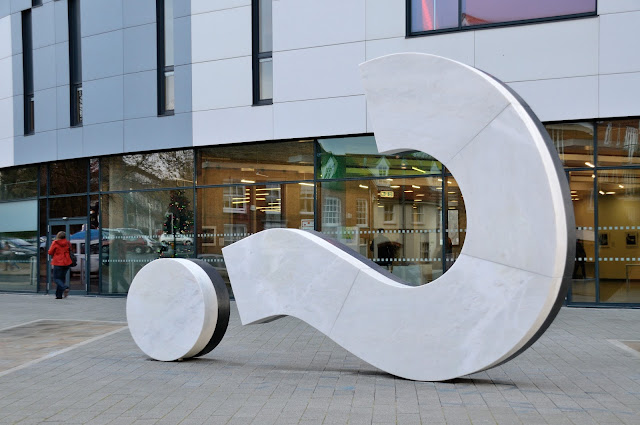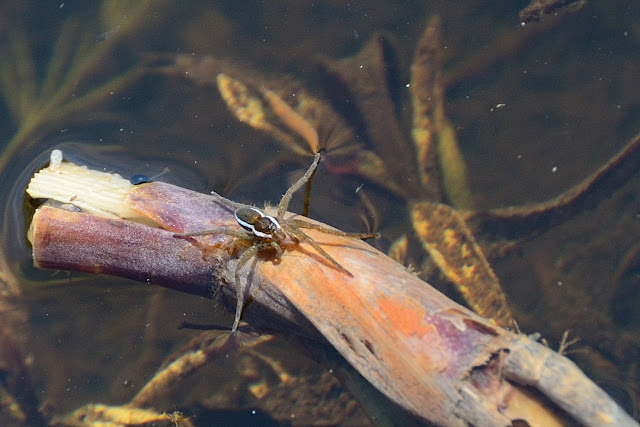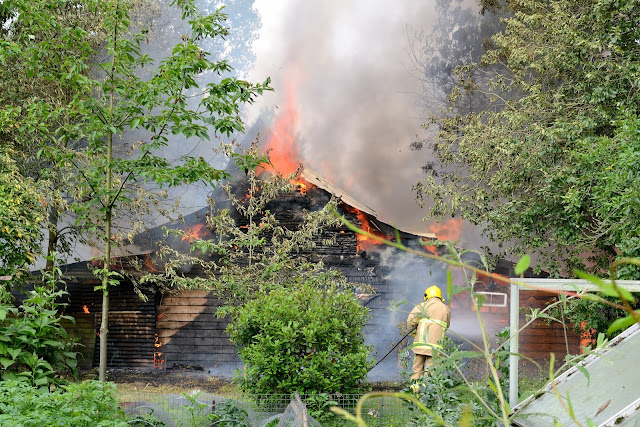This is my second offering of Ipswich art as I saw it. Some of it is not exactly of the date of this entry, as I have tried to group the images together. However, most images were take `around` this time! This first image was probable the newest of the group, and one of my favourites.
THE QUESTION?
2011 UCS Waterfront
Marble and granite
The two-part work, created by internationally-acclaimed artists Langlands & Bell, is linked to an LED screen on top of the town’s iconic chimney tower at the Campus North site. It was financed by the university and grants of £75,000 from Arts Council England and £25,000 from Ipswich Borough Council.
THE QUESTION (2)
Linking with image above, on other half of UCE
PRINCE ALEXANDER OBOLENSKY
Cromwell Square, St. Nicholas Street
2009 Harry Gray
Stone and bronze
Artist Harry Gray was commissioned to make this artwork which mirrors the excitement and speed of the game and is in the style of the futurist 1930’s modernism.
Prince Alexander Obolensky was born in St Petersburg, the son of Prince Serge Obolensky and his wife Princess Luba. The year after his birth the Russian Revolution broke out and the family fled to England, settling in North London. Prince Alexander studied at Oxford University where he played Rugby
football and went on to play for Leicester and England. His selection for England caused a stir because he was not English but gained British citizenship in 1936. He was killed during the Battle of Britain when his Hawker Hurricane crashed on Martlesham Heath near Ipswich whilst training in 1940. He is buried in Ipswich Cemetery.
THE CLASPED HANDS
South West corner of Christchurch Park
David Good
Ash
The clasped hands are near the St Margaret's Plain entrance to Christchurch Park. Ipswich Rangers and Parks Department commissioned chainsaw sculptors to work on the ash trees in the Park which presented a threat of falling branches. This is one of two.
TRIPLE MYCOMORPH
1992 Christchurch Park
Bernard Reynolds
Aluminium
This piece commissioned by Tom Gondris, was originally made in plaster in 1953 and was later cast into metal in 1992. The sculptor explained that - "Tom Gondris came to my studio to select from my past work a sculpture which he felt could symbolise the continuous resurgence of life. He chose this Triple Mycomorph.... to be a memorial to his parents who disappeared on the 'Continent' during World War II".
Born in Norwich in 1915 and trained at Norwich School of Art, Bernard Reynolds met and exhibited with Henry Moore in 1936-37. From 1949 he organised nine exhibitions of East Anglian Sculpture. He was Lecturer in Charge of Three-dimensional Design, Suffolk College until 1980.
ST PETERS GATES
2008 St Peter's Church
Paul Richardson
Steel
These gates were commissioned by the Ipswich Hospital Band, who converted the deconsecrated church into a concert venue. They show 'angels of music' to combine the new role of St Peters while staying in sympathy with the church architecture.
The angels' wings echo parts of the wind instruments from the Hospital Band. Playing flute and horn, they hover over water under a starry sky, celebrating the new home of music at the waterfront. They were installed in spring 2008.
BARLEY SCULPTURE
1999 Maltings, Felaw Street
Venessa Parker
Steel
Felaw Maltings is a heritage building which has been redeveloped as part of the waterfront regeneration in Ipswich. The waterfront regeneration has introduced unusual examples of public art including this sculpture in the form of barley sheaves by Venessa Parker which reflects the building's previous use.
The stems are made from steel tubes of various in diameters, the heads of barley are made from 5 mm plate steel and layered for texture.
TRIDENT WITH NETS
2000 Neptune Quay
Venessa Parker
Steel
The Trident stands tall in the courtyard of the Neptune Quay flats. You cannot get close enough for a good look as the gates are only open to residents. This photo is taken from inside the courtyard which gives the best view. Yes, someone let me in!
A QUICK STEP TO RECOVERY
2004 Ipswich Hospital
Paul Richardson
Steel
A Quick Step to Recovery, consists of two stylish dancing couples with wide grins. They have been placed in a courtyard on the south side of the hospital, an area surrounded by corridors just off entrance 2.
Paul spent time in the hospital thinking about what he would make and as he watched the bustle of activity it reminded him of the movements of a dance.
The sculptures are made out of steel that was cut, bent and welded into position piece by piece. They took about four and a half months to build. They were painted to make them weatherproof and together they weigh around one ton.
SWANS
Toyota Garage
The Havens
The origins of this sculpture are unknown
FLIGHTPOST
2006 Ravenswood Health Centre
Andrew Smith
Stainless Steel
Andrew Smith, a very experienced artist, craftsman and tutor, trained at the RCA. He has a large portfolio of architectural commissions, from sculpture to functional metalwork. Situated in a Modern Open Piazza on a redeveloped RAF Aerodrome, 'Flightpost' is a reference to gateways and portals as
well as flight and take-off. One post stands still in the open space, rather like a person, while the other element becomes animated and 'takes off' in to the sky in a manner referential to vertical take-off flying machines and rockets.
HANDSTANDING
2006 Near Ravenswood Primary School
Martin Heron
Steel
Handstanding' was produced as a response to Ravenswood and the surrounding community. It was commissioned by Ipswich Borough Council in partnership with Bellway Homes. The commission involved the design and production of a centrepiece sculpture and a number of small linked interventions.
‘Handstanding’ is a celebratory work: it has youthful energy in its pose but is a form which is strong and robust. It symbolises the aspirations of a new and growing community and what can be achieved by joining together.
The material used is cor-ten steel also known as ‘weathering steel’. It is designed to rust but will not decay. Instead it goes through a distinct colour change and eventually seals itself and remains the same colour. The work was fabricated and installed by Art Fabrications based in Warwickshire.
FORMATION
2003 Ravenswood
Rick Kirby
Steel
The flying figures in Formation greet you as you enter the new Ravenswood development on the edge of Ipswich, built on the site of the old airport. The six figures are closely connected and the whole form sweeps up and away in a 'symbolic' flypast. This figurative work commemorates the role of the RAF and its personnel. Rick Kirby was inspired by a 2nd World War poster of planes flying in formation, being tracked by searchlights. This has been represented by the female form which is a reference to planes and ships being feminine.
The supporting columns of the work mirrors the idea of five beams of light. The work was hand-crafted by the artist using fabricated mild stainless-steel plate. These are small plates welded together, giving texture and strength to his work. The work is lit from the base and is approximately 6 metres high. It was officially opened by the Mayoress in 2003.
MAN AND BALL
2000 Ransomes Way, nr B&Q
Giles Penny
Bronze
Giles works on large sculpture commissions as well as producing smaller pieces. He makes mostly figurative work which often has a humorous quality.
We in Ipswich do not have the only Man and Ball, there is also one in Cheltenham and one in Portsmouth.
Giles Penny was trained at the Heatherley School of Art, Chelsea and Newport College of Art in the late 1970’s and early 1980’s. He has exhibited widely during his career.
INNOCENCE
2007 Christchurch Park
Linda Thomas
Portland stone
Viewing is during park opening hours. See www.ipswich.gov.uk. An elegant white marker with a tapered 'eye' to the top right, which reflects the pattern of light and shade from the nearby trees. The sculpture is the artist’s response to the restoration of Christchurch Park. Inspired by the beautiful windows in the main entrance to Christchurch Mansion; the artist decided to take the window into the park.
The artwork contrasts people with the landscape, traditional with contemporary and new with old. The sculpture provides a constantly running live video showing in one direction a traditional rolling landscape and in the other the fun and innocence of children at play.
The artwork has the dimensions of the ‘golden ratio’ and is carved out of a single piece of Portland stone (Bowers Basebed) quarried from Portland in Dorset. It is a material which is tactile encouraging the viewer to fully interact with the piece.
ORCHARD LIFE
1999 Orchard Street
Jonathan Clarke
Aluminium
Powerful and compelling, Jonathan Clarke' s sculptures are informed by current social issues. His sand-cast aluminium sculptures have a classical discipline, dispassionate and impersonal. From the age of sixteen Jonathan served his apprenticeship in his father Geoffrey' s studio and foundry, learning to master the means of sand-cast aluminium. Without any preparatory drawings Jonathan goes straight into the work, carving polystyrene into components which make up the finished piece. There is an immediacy and directness of approach reflected in the robust construction of the imagery. The advantage in being brought up within the artistic environment at home, instead of going through the art school process, has served to give Jonathan a sound appreciation of the workmanlike virtues of making sculpture.
THE RHUMBA
1994-95 Ransomes Way, nr B&Q
Peter Blunsden
The site was once an engineering works, making goods such as some of the early aircraft, steam locomotives and lawnmowers and this sculpture reflects the industrial past of the site. The Rhumba is a cuban dance involving much exaggerated hip movement. Peter Blunsden is a sculptor based in Norfolk, born in 1949. He studied at Norwich School of Art and Anglia Polytechnic University.
This piece featured in the Hardingham Sculpture show in Christchurch Park in the Summer of 1995. Blunsden normally works in this way, constructing large-scale, often painted welded metal pieces from ready made and worked fragments of steel. His work explores space and creates internal rhythms. Although apparently abstract, his sculptures appear to have figurative possibilities






























































